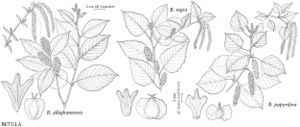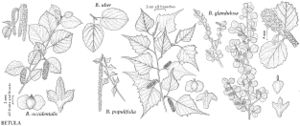Difference between revisions of "Betulaceae"
FNA>Volume Importer |
FNA>Volume Importer |
||
| Line 13: | Line 13: | ||
}}<!-- | }}<!-- | ||
| − | --><span class="statement" id="st- | + | --><span class="statement" id="st-undefined" data-properties=""><b>Trees </b>and shrubs, deciduous. <b>Winter</b> buds stipitate or sessile, with either 2–3 valvate scales (stipules) or few to many imbricate scales (or occasionally naked); terminal bud absent. <b>Leaves</b> alternate, spirally arranged, 2–3-ranked, simple; stipules deciduous, distinct; petioles present. <b>Leaf</b> blade sometimes lobed, pinnately veined, margins toothed, serrate to nearly entire; surfaces glabrous to tomentose, abaxially often with resinous glands. <b>Inflorescences</b> unisexual; staminate catkins pendulous, elongate, cylindric, conspicuously bracteate, consisting of crowded, reduced, 1–3-flowered clusters; pistillate inflorescences either of erect to pendulous bracteate catkins, or of compact 2–3-flowered clusters subtended by leafy involucres; bracts often nearly foliaceous or woody in infructescences. <b>Staminate</b> flowers bracteate; stamens (1–)4–6; anthers 2-locular, dehiscing by longitudinal slits, pollen sacs often ± distinct; pistillode sometimes present. <b>Pistillate</b> flowers small, highly reduced; pistil 1, 2(–3)-carpellate; ovary inferior, usually 2-locular proximally, 1-locular distally; placentation axile; ovules 1–2 per locule, pendulous; styles 2, distinct or nearly so; stigmas dry; staminodes usually absent. <b>Fruits</b> nuts, nutlets, or 2-winged samaras, 1-seeded, without multibracteate cupule, often subtended or enclosed by foliaceous hull developed from 2–3 bracts; seed coat membranous; endosperm present, thin at maturity; embryo straight, as long as seed; cotyledons flat or greatly thickened, oily.</span><!-- |
-->{{Treatment/Body | -->{{Treatment/Body | ||
| Line 127: | Line 127: | ||
|publication year= | |publication year= | ||
|special status= | |special status= | ||
| − | |source xml=https://jpend@bitbucket.org/aafc-mbb/fna- | + | |source xml=https://jpend@bitbucket.org/aafc-mbb/fna-data-curation.git/src/9216fc802291cd3df363fd52122300479582ede7/coarse_grained_fna_xml/V3/V3_971.xml |
| − | |||
| − | |||
| − | |||
| − | |||
| − | |||
| − | |||
| − | |||
| − | |||
| − | |||
| − | |||
| − | |||
| − | |||
| − | |||
| − | |||
| − | |||
| − | |||
| − | |||
| − | |||
| − | |||
| − | |||
| − | |||
| − | |||
| − | |||
| − | |||
| − | |||
| − | |||
| − | |||
| − | |||
| − | |||
| − | |||
| − | |||
| − | |||
| − | |||
| − | |||
| − | |||
| − | |||
| − | |||
| − | |||
| − | |||
| − | |||
| − | |||
| − | |||
| − | |||
| − | |||
| − | |||
| − | |||
| − | |||
| − | |||
| − | |||
| − | |||
| − | |||
| − | |||
| − | |||
| − | |||
| − | |||
| − | |||
| − | |||
| − | |||
| − | |||
| − | |||
| − | |||
| − | |||
| − | |||
}}<!-- | }}<!-- | ||
-->[[Category:Treatment]] | -->[[Category:Treatment]] | ||
Revision as of 13:54, 27 July 2019
Trees and shrubs, deciduous. Winter buds stipitate or sessile, with either 2–3 valvate scales (stipules) or few to many imbricate scales (or occasionally naked); terminal bud absent. Leaves alternate, spirally arranged, 2–3-ranked, simple; stipules deciduous, distinct; petioles present. Leaf blade sometimes lobed, pinnately veined, margins toothed, serrate to nearly entire; surfaces glabrous to tomentose, abaxially often with resinous glands. Inflorescences unisexual; staminate catkins pendulous, elongate, cylindric, conspicuously bracteate, consisting of crowded, reduced, 1–3-flowered clusters; pistillate inflorescences either of erect to pendulous bracteate catkins, or of compact 2–3-flowered clusters subtended by leafy involucres; bracts often nearly foliaceous or woody in infructescences. Staminate flowers bracteate; stamens (1–)4–6; anthers 2-locular, dehiscing by longitudinal slits, pollen sacs often ± distinct; pistillode sometimes present. Pistillate flowers small, highly reduced; pistil 1, 2(–3)-carpellate; ovary inferior, usually 2-locular proximally, 1-locular distally; placentation axile; ovules 1–2 per locule, pendulous; styles 2, distinct or nearly so; stigmas dry; staminodes usually absent. Fruits nuts, nutlets, or 2-winged samaras, 1-seeded, without multibracteate cupule, often subtended or enclosed by foliaceous hull developed from 2–3 bracts; seed coat membranous; endosperm present, thin at maturity; embryo straight, as long as seed; cotyledons flat or greatly thickened, oily.
Distribution
Primarily boreal and cool temperate zones of Northern Hemisphere
Discussion
Genera 6, species ca. 125 (5 genera, 33 species in the flora).
Betulaceae belong to an ancient lineage, traceable in the fossil record to the upper Cretaceous. They are easily distinguished by their woody habit; simple, pinnately veined, usually ovate, sharp-toothed leaves; long staminate catkins that often develop the season before anthesis; and (except in Corylus and Ostryopsis) strobiluslike infructescences. The family is held together on the basis of many features, including habit, leaf structure and arrangement, trichome morphology, wood anatomy, inflorescence morphology, ovary and ovule structure, pollen morphology, embryo structure, and fertilization and germination patterns. Five of the six constituent genera inhabit the boreal and cool temperate zones of Eurasia, North America, and the mountains of Mexico and Central America, and two genera also grow in the Andes to northern Argentina in South America. The remaining genus, Ostryopsis Decaisne (most closely related to Corylus Linnaeus), consists of two species of shrubs restricted to northern and western China.
The group is sometimes divided into two families, Betulaceae (Alnus and Betula) and Corylaceae (Carpinus, Ostrya, Corylus, and Ostryopsis), especially in Europe (e.g., H. K. Airy Shaw in J. C. Willis 1973; R. M. T. Dahlgren 1980; J. Hutchinson 1959). In America, this treatment has been followed by A. J. Rehder (1940), J. K. Small (1903), and a few others. Some of those writers have based their recognition of two families in part on the belief that a fundamental difference exists in the staminate inflorescences of the two groups. This view is no longer widely accepted, and most modern authors maintain the family as a single group composed of two subfamilies, Betuloideae and Coryloideae.
Betulaceae may have been derived from hamamelidaceous stock (O. Tippo 1938); this idea has been advanced by others (e.g., J. A. Doyle 1969; P. K. Endress 1977; M. W. Chase et al. 1993). The ancestor of more advanced Hamamelidae (including Betulaceae) may have been a member of the Normapolles complex, a Cretaceous fossil pollen flora that includes grains similar in structure to those of the modern Betulaceae (J. A. Doyle 1969). The pollen of modern Betulaceae is much more specialized than that of modern Hamamelidales, however, and the relationships of the Normapolles complex to Juglandaceae, Fagaceae, and other amentiferous groups, as well as to Betulaceae, are not certain. Additional fossil information will be needed if botanists are to gain stronger insights into the phylogeny of these families (P. R. Crane 1989; K. C. Nixon 1989).
The most obvious evolutionary trends within the family are those related to fruit dispersal (winged fruits in the Betuloideae, nutlets with accessory winglike bracts in Carpinus and Ostrya, and dispersal by small mammals in Corylus), and with apparent adaptations for survival in cold climates (including shrubby growth forms, small leaves, and the protection of pistillate catkins during winter by bud scales in boreal species). Some radiation has also occurred with respect to the pollination system (E. J. Jäger 1980). Please see P. R. Crane (1989) and J. J. Furlow (1990) for reviews of literature related to the origin and diversification of the family.
Members of Betulaceae are economically important as timber trees, as the source of hazelnuts and filberts (Corylus), as ornamental trees and shrubs, and as aids in soil nitrification and stabilization (Alnus). Some are important as causes of pollen allergies in regions where they grow abundantly.
Selected References
Illustrations
Key
| 1 | Infructescences 1-4 cm, conelike, of small, crowded, woody or leathery scales, these deciduous with fruits or persistent; fruits tiny samaras, laterally winged, wings sometimes reduced to ridges; pericarp thin, leathery (subfamily Betuloideae). | > 2 |
| 1 | Infructescences mostly longer than 4 cm, of relatively uncrowded clusters with large, nearly foliaceous bracts, these deciduous with fruits; fruits tiny to moderately large nuts, hard-shelled, not winged (subfamily Coryloideae). | > 3 |
| 2 | Winter buds stipitate (nearly sessile in some species); stamens (3-)4(-6), anthers and filaments undivided; pistillate flowers 2 per scale; infructescence scales with 5 lobes, greatly thickened, woody, persistent long after release of fruits. | Alnus |
| 2 | Winter buds sessile; stamens usually (1-)2-3(-4), filaments divided below anthers; pistillate flowers (1-)3 per scale; infructescence scales with (1-)3 lobes, thickened or leathery but not woody, usually deciduous with release of fruits. | Betula |
| 3 | Leaf blade broadly ovate to nearly orbiculate, lateral veins 8 or fewer pairs; infructescence irregular cluster of several nuts, each nut usually 1 cm or more, surrounded by involucre of several coarsely toothed, leaflike bracts, involucre sometimes long and tubular (tribe Coryleae). | Corylus |
| 3 | Leaf blade narrowly ovate to elliptic, lateral veins 10 or more pairs; infructescence elongate, loosely arranged racemose cluster of 3 or more pairs of leafy bracts, each bract either subtending or enclosing single nutlet, nutlet less than 0.8 cm (tribe Carpineae). | > 4 |
| 4 | Infructescence bracts flat, open, (1-)3-lobed, variously toothed. | Carpinus |
| 4 | Infructescence bracts forming inflated bladders, these completely enclosing fruits. | Ostrya |


